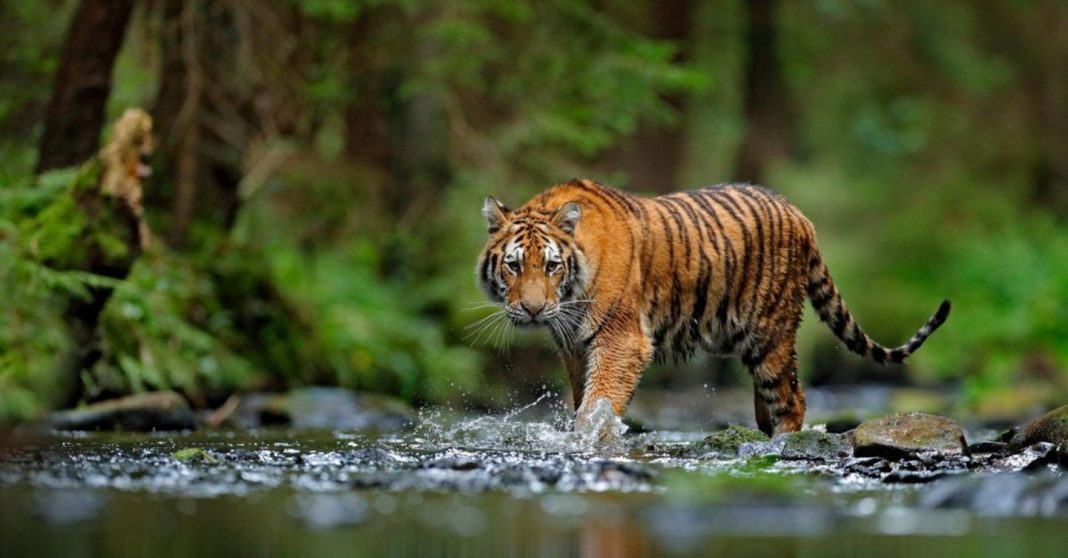Kaziranga Tiger Density has recently reached the third highest in India, marking a proud moment for both Assam and the nation. This achievement shows the success of India’s tiger conservation programs and highlights Kaziranga’s role as one of the world’s most important wildlife habitats. For children and adults alike, the story of Kaziranga is both educational and inspiring, as it demonstrates how nature can flourish when humans work to protect it.
Kaziranga Tiger Reserve is located in Assam, a state in the northeastern part of India. It covers parts of the Nagaon, Golaghat, Karbi Anglong, and Sonitpur districts. The reserve is part of the larger Kaziranga National Park, which was declared a UNESCO World Heritage Site in 1985.
Kaziranga is not only home to the largest population of the one-horned rhinoceros, but it also shelters elephants, swamp deer, water buffaloes, and a wide range of birds. In 2007, Kaziranga was officially recognized as a Tiger Reserve under Project Tiger, making it one of India’s most important wildlife sanctuaries.
What Does Kaziranga Tiger Density Mean?
When we say Kaziranga Tiger Density is among the highest in India, we refer to the number of tigers per 100 square kilometers.
Why is Tiger Density Important?
- A higher tiger density indicates that the forest is healthy and supports enough prey for tigers.
- It shows that conservation measures are working successfully.
- Tiger density helps compare different tiger reserves and shows which ones are leading in tiger protection.
Thus, when we say Kaziranga Tiger Reserve Records Third Highest Tiger Density, it means that only two reserves in India currently have more tigers per 100 square kilometers than Kaziranga.
Reasons Why Kaziranga Tiger Reserve Records Third Highest Tiger Density
The success of Kaziranga in achieving the third highest tiger density is the result of several factors:
Natural Habitat and Geography
- Kaziranga lies on the floodplains of the mighty Brahmaputra River.
- The park has a mix of tall grasslands, swampy marshes, dense forests, and river islands, which provide perfect hiding and hunting grounds for tigers.
- Seasonal floods also enrich the soil, helping plants grow and supporting a large population of prey animals.
Abundant Prey Base
- Tigers are carnivores and need a steady supply of prey.
- Kaziranga is home to animals like hog deer, sambar deer, swamp deer, wild buffalo, and wild boar, ensuring that tigers have enough food.
- A healthy prey population is one of the main reasons why Kaziranga Tiger Reserve Records Third Highest Tiger Density.
Strict Protection Measures
- The Assam Forest Department, with the help of the central government, has enforced strong anti-poaching laws.
- Forest guards patrol the park day and night, often risking their lives.
- Modern technology like camera traps, drones, GPS collars, and CCTVs are used to monitor tiger activity and prevent illegal hunting.
Community Participation and Eco-Tourism
- Villages around Kaziranga actively take part in protecting wildlife.
- Eco-tourism provides income to locals, making them partners in conservation.
- Many young people are trained as tourist guides, spreading awareness about the importance of tigers.
Why the Achievement Matters: Kaziranga Tiger Reserve Records Third Highest Tiger Density
The fact that Kaziranga Tiger Reserve Records Third Highest Tiger Density is significant for several reasons:
- For Nature: It proves that Kaziranga has one of the healthiest ecosystems in India.
- For Tigers: Tigers are endangered worldwide, and this achievement shows their numbers can grow if properly protected.
- For India: India is home to over 70% of the world’s wild tigers, so Kaziranga’s success strengthens India’s role as a global leader in tiger conservation.
- For the World: The methods used in Kaziranga can be a model for other countries where tiger populations are shrinking.
The Role of Tigers in Maintaining Balance
When we say Kaziranga Tiger Reserve Records Third Highest Tiger Density, we must also understand why tigers are so important.
Tigers as Top Predators
- Tigers control the population of herbivores like deer and boars.
- This prevents overgrazing, helping forests and grasslands remain healthy.
Symbol of a Healthy Ecosystem
- A large number of tigers means there are enough prey, clean rivers, and thick forests.
- Tigers are called umbrella species because protecting them automatically protects many other plants and animals.
Cultural and Economic Value
- Tigers are part of India’s cultural heritage.
- Wildlife tourism in Kaziranga brings thousands of visitors every year, benefiting local communities.
Challenges Despite Success
Even though Kaziranga Tiger Reserve Records Third Highest Tiger Density, challenges remain:
- Annual Floods: The Brahmaputra floods often force animals, including tigers, to move to higher ground, leading to human-animal conflict.
- Poaching Threats: Though reduced, poaching for tiger skins and bones still exists.
- Human Encroachment: Expanding villages and farming areas reduce forest land.
- Climate Change: Changing rainfall and rising temperatures threaten the delicate balance of Kaziranga’s ecosystem.
Future of Kaziranga After Recording Third Highest Tiger Density
The success that Kaziranga Tiger Reserve Records Third Highest Tiger Density must be continued. Steps for the future include:
- Expanding protected areas and creating wildlife corridors.
- Using more technology to track and study tigers.
- Involving more schools and students in awareness campaigns.
- Training more local youth for eco-tourism and wildlife protection.
Conclusion:Kaziranga Tiger Density as a Model for Conservation Success
The fact that Kaziranga Tiger Reserve Records Third Highest Tiger Density is a historic and inspiring achievement. It proves that with dedication, teamwork, and care for nature, endangered animals like the Royal Bengal Tiger can thrive again. For students and adults alike, Kaziranga’s story is a reminder that protecting nature means protecting our future.



